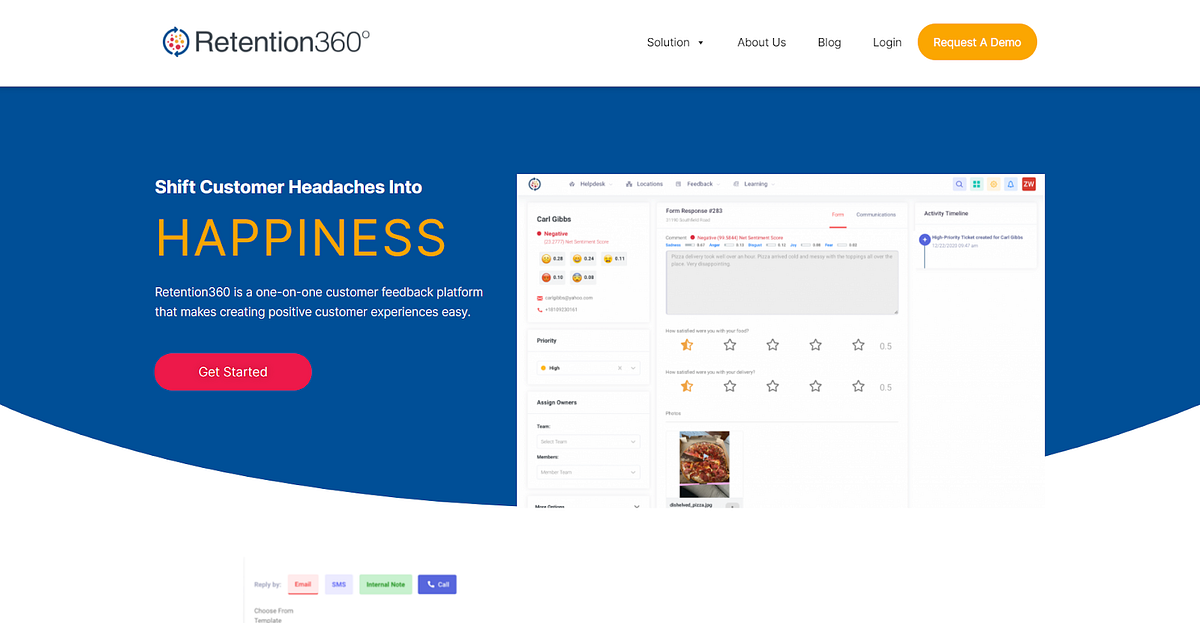With millions of companies competing for consumer attention, it’s no secret that strong customer experiences are consistently the demarcating line between successful businesses and those that languish.
In order to create the former, you’ll need more than just a few satisfied customers–you need hordes of passionate ones.
That’s where Retention360 comes in.
We’re a dedicated customer retention software platform that offers four key features that are essential to any business looking to create a strong, lasting relationship with its customers. And in this post, we’ll discuss each in detail, helping you understand how each can help take your business to the next level.

But first, why customer retention?
Short answer: ROI.
Long answer: Investing in customer retention has been shown to have a significantly higher ROI than acquisition. Acquiring customers is hard, and costly-–the average cost of acquiring a new customer is five to 25 times more expensive than retaining an existing one.
But that’s not all–customer retention also leads to increased brand loyalty, which in turn leads to increased revenue and profitability. In fact, a 5% increase in customer retention can lead to a 95% increase in profitability, according to Bain & Company.
Additionally, happy customers are more likely to refer your business to others, which can help you acquire new customers at a lower cost. By one estimate, a 10% increase in referrals can lead to a 30% decrease in acquisition costs.
It’s clear that customer retention should be a key focus for any business looking to create long-term success. So let’s take a look at how Retention360 can help you achieve this goal.
Customer feedback capture tool
By far the most essential component of any customer retention strategy is feedback. After all, how can you improve the customer experience if you don’t know what your customers are thinking and feeling?
Retention360’s customer feedback capture tool helps you stay on top of this critical information by offering both QR code and email survey capabilities. That way, you can quickly and easily gather feedback from customers after they’ve interacted with your business.
With our customizable survey builder, you can create surveys that target specific pain points and customer touchpoints. And because our platform integrates with all major CRMs, you can be sure that your feedback data will be seamlessly integrated into your existing systems.
Automated customer sentiment analysis
Of course, gathering feedback is only half the battle. The other half is making sense of it all.
That’s where our automated customer sentiment analysis comes in. This powerful feature takes all of the guesswork out of understanding customer feedback by automatically identifying positive, negative, and neutral sentiment.
In addition, we provide detailed insights and recommendations based on this sentiment analysis–insights that you can use to improve the overall customer experience.
Direct & social media response tools
In today’s social media-driven world, it’s more important than ever to have a strong presence on platforms like Twitter, Facebook, and Instagram. Not only do these platforms provide an excellent way to connect with potential customers, but they also offer a unique opportunity to build brand loyalty among current ones.
However, managing social media accounts can be a full-time job in and of itself–which is why we offer direct and social media response tools as part of our platform. With these tools, you can quickly and easily respond to customers across all major social media platforms–all from one central location.
What’s more, our platform makes it easy to track social media conversations so you can see which interactions are driving the most engagement (and make adjustments accordingly).
Prioritization dashboard for customer success teams
No matter how strong your retention strategy may be, there will always be a small percentage of customers who fall through the cracks. That’s why it’s essential to have a prioritization dashboard for your customer success team.
Our platform offers just such a dashboard–one that gives your team visibility into every at-risk account so they can take proactive steps to prevent churn before it happens.
In addition, the dashboard makes it easy to track customer health over time so you can identify (and address) any potential issues before they cause long-term damage.
High quality reporting, including location-based reporting for restaurants and other chains
As a business owner, you need to have a clear understanding of how your customers interact with your brand. This includes everything from what location they’re in when they make a purchase to what device they’re using.
Retention360’s high quality reporting offers this level of insights and more, giving you the ability to track customer behavior across all channels. This is especially useful for businesses with multiple locations, such as restaurants, as it allows you to see how each location is performing and make necessary adjustments.
In addition, our reporting is 100% compliant, meaning you can be sure that all the data you’re collecting is above-board. Never worry about being in violation of data privacy laws again.
Omnichannel automated outreach
To create strong customer experiences, you need to be able to communicate with your customers where they are–and that means being present on all the channels they use.
With Retention360’s omnichannel automated outreach, you can do just that. We’ll help you connect with customers on the channels they prefer, whether that’s email, SMS, social media, or even in-app messaging.
What’s more, our automated outreach is designed to be highly personalized, meaning each customer will feel like you’re speaking directly to them. No more generic messages–with Retention360, it’ll feel like you’re having a one-on-one conversation with every customer.
Ticketing dashboard to track customer inquiries
It’s important to always be responsive to your customers’ needs, and our ticketing dashboard makes it easy to do just that. We’ll help you keep track of all customer inquiries in one place, so you can be sure that nothing falls through the cracks.
Additionally, our dashboard makes it easy to assign and manage customers, so you can be sure that each inquiry is being handled by the right team member. No more frustrated customers–with Retention360, they’ll always know that their concerns are being addressed.
From implementation to action
Our team has helped dozens of businesses just like yours transform their acquisition costs and significantly improve their growth. Just ask some of our clients, like BIGGBY:
“We were able to completely overhaul our customer experience team and turned what used to be a disorganized process into a streamlined approach. Saving us time & money, while building better relationships with our customers” – BIGGBY team
Retention360 was founded on providing real, tangible improvements, and the results show. Read more testimonials here.
Getting started
Our team guides you every step of the way. If you’re looking to create a more customer-centric culture, we can help you develop the right processes and policies. We’ll also train your staff on how to use our platform so that they can get the most out of it.
In short, we’re here to help you from A to Z–from implementation to action. We’ve spent years refining our platform and perfecting our craft, and we’re confident that we can help you take your business to the next level.
Ready to start creating amazing customer experiences that lead to long-term success?
What our demos look like
Just fill out our short demo form and one of our product experts will be in touch to show you how Retention360 can help take your business to the next level.
In particular, they’ll start by showing you how our platform can help you:
– Increase customer retention and loyalty
– Boost revenue and profitability
– Reduce acquisition costs
– Improve your brand image
After a brief demonstration of the platform, they’ll answer any questions you have and help you get started with onboarding. We’ll compare your business needs with our features and make sure Retention360 is the right fit for you.
There’s no risk and no obligation–so why not see how Retention360 can help your business today? Click the link to get started!
Final thoughts: perfecting the customer experience with Retention360
In summary, Retention360 is the perfect tool for businesses looking to create strong, lasting relationships with their customers. We offer automated sentiment analysis, high quality reporting, direct response tools, omnichannel automated outreach, and compliance assistance, all of which are essential for any business wanting to take their customer experience to the next level.
If you’re looking for a customer retention software that can help you create the perfect customer experience, look no further than us!




























